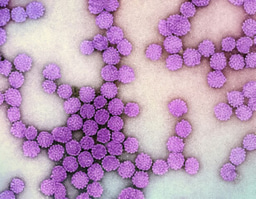Why are the genetic codes for protein translation composed of three nucleotide bases? Nowadays the answer is obvious: 2, 3, and 4 bases can give 16, 64, and 128 combinations. 16 is insufficient to code for 20 amino acids, and 128 is unnecessarily too many. 64 will be the right number needed. From here we also can derive three codes for one amino acid (including STOP) on average and the concept of wobble base.
This sounds easy, right? (If your molecular biology 101 did not explain it, please go asking for tuition refund.) However, let's imagine that all the knowledge you have is the double helix structure of DNA, RNA is not found and ribosome function is mystic, the amino acid sequences are known only in a few polypeptide fragments, how would you connect DNA with protein products? That was exactly the "coding" question from Crick and Watson when they proposed DNA structure.
Surprisingly, it's not those ingenious folks at Cambridge (in either countries) to answer this question, but two groups of people with contrasting backgrounds: physicists and biochemists. They were coming to Bethesda, Maryland, in 1950s to decode it.
In 1934, while many scientists fled Europe to escape from Nazi, George Gamow and his wife run away from Soviet Union to US. As a well-known theoretical nuclear physicists, he soon got an offer of theoretical physics professor from George Washington University (GWU) at DC. Moreover, his proposal to hire his friend, Edward Teller, who designed the first H-bomb years later, was also accepted by the generous president of GWU. The next year, Gamow's son was born, and the family bought a house in Bethesda. From a archived letter that Gamow sent to Vannevar Bush, the house located in Thoreau Drive, which is 8 min drive to NIH campus and 20 min drive through the road by the Potomac River to GWU. Teller and his wife stopped by the house all the time, and Einstein had visited the family there once.
Gamow was knowledgeable in the renaissance man style. When Crick and Watson published the DNA structure in Nature in 1953, it became his new pursuit immediately. Gamow wrote to Watson and Crick with his idea how four bases could be arranged to code the 20 amino acids. Watson was very impressed; when he traveled to DC, he visited Gamow at his house in Bethesda. Gamow proposed the first model of genetic code, "diamond code". Through mathematical consideration, it evolved to become triplet code that set foundation for experimental proof.
Years later, Crick wrote: "The importance of Gamow's work was that it was really an abstract theory of coding, and was not cluttered up by a lot of unnecessary chemical details...."
In 1954, Gamow was on sabbatical at the University of California, Berkeley. There he and Watson form the "RNA Tie Club", consisted of 20 eminent scientists, each of whom corresponded to an amino acid, plus four honorary members, one for each nucleotide. Each member received a woolen necktie having an embroidered helix as RNA. Six members eventually became Nobel laureates: Richard Feynman, Melvin Calvin, James Watson, Max Delbruck, Francis Crick and Sydney Brenner. The RNA Tie Club never had a formal meeting of all its members. They visited each other to discuss the scientific developments, usually involving cigars and alcohol. In a few years, this group developed the hypotheses of codon and adaptor (proved to be tRNA later), giving huge impacts on the concepts of protein synthesis. However, However, the RNA Tie Club never reached the ultimate goal of deciphering the code linking nucleic acids and amino acids. This was achieved by a stranger to these prominent scientist: Marshall Nirenberg, who came to Bethesda in 1957.
That was the year that Nirenberg received his Ph.D. from University of Michigan, Ann Arbor, where he studied metabolism in tumor. He joined National Institute of Arthritis and Metabolic Diseases (currently National Institute of Arthritis and Musculoskeletal and Skin Diseases, NIAMS) at NIH right away to begin the postdoctoral research. Two years later he was promoted to a permanent position, and worked together with Heinrich J. Matthaei for the goal to find how base sequences determine amino acids in proteins. In 1961, Francis Crick, Sydney Brenner, Leslie Barnett and R.J. Watts-Tobin used proflavin to induce single-nucleotide insertion or deletion of phage genome. They found that, when the three neighboring bases were deleted, the synthesized protein remained functional. This result proved George Gamow's triplet codon idea. On this basis, Nirenberg and Matthaei designed a series of experiments. They reconstituted protein synthesis in vitro from the lysate of E. coli, degraded DNA, added synthesized RNA of a repetitive sequence, and spiked one radiolabeled ("hot") together with 19 unlabeled ("cold") amino acids. When the "hot" amino acid was incorporated into the synthesized protein, the RNA sequence must contain the corresponding codon. At 3 am (!) on May 27, 1961, Matthaei found hot phenylalanine incorporated into protein generated from Poly(U) RNA, and UUU -> Phe became the very first identified genetic code.
When Nirenberg presented the result of the experiment, it arouse a furious race of cracking the full set of genetic codes. Nirenberg's competitor even included Severo Ochoa, who shared the 1959 Nobel Prize with Arthur Kornberg. However, many scientists at the NIH were aware that it may lead to the first Nobel Prize by an intramural NIH scientist, so they rallied behind Nirenberg to boost the progress of the experiments. DeWitt Stetten Jr., the NIH director who first hired Nirenberg, called this period of collaboration "NIH's finest hour." In 1962, this group published all the genetic codons for the 20 amino acids. The achievement led to the Nobel Prize awarded to Nirenberg in 1968, with his intramural collaborators as the unsung heroes.
The stories of Bethesda decoders inspire the generations of NIH scientists. However, the legend did not end there. This is just Part I. After 30 years, the NIH would launch the Part II of Bethesda decoders: The Human Genome Project.
To be continued!





Please sign in or register for FREE
If you are a registered user on Research Communities by Springer Nature, please sign in